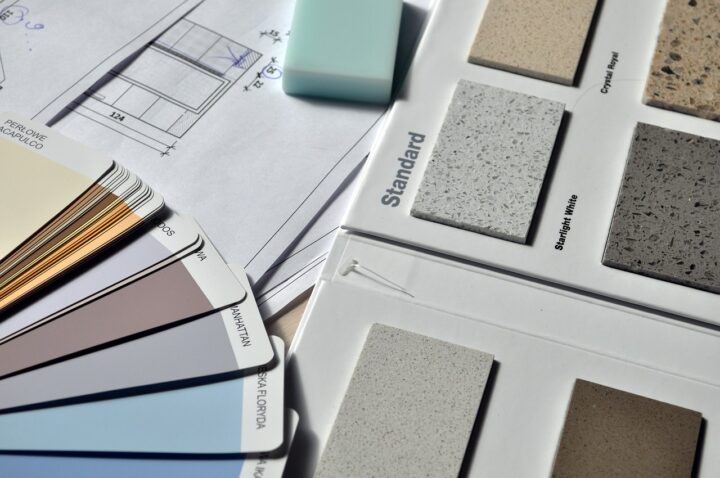Creating a minimalist color palette for your home is a great way to achieve a clean and organized look. This step-by-step guide will walk you through the process of selecting the perfect colors for your space. By following these simple steps, you will be able to create a harmonious and cohesive color scheme that promotes a sense of calm and simplicity in your home.
Determine your color scheme
Choose a base color that will set the tone for your home. Start by considering neutral shades like white, gray, or beige. These colors provide a versatile and timeless backdrop for your space. To determine the best base color, assess the overall style and ambiance you want to create. For a clean and contemporary look, opt for crisp white walls. If you prefer a more serene and calming atmosphere, go for soft gray tones. For a warm and inviting feel, choose a soothing beige hue. Remember, the base color will serve as the foundation for your color scheme, so select one that resonates with your desired aesthetic.
Once you have chosen your base color, it’s time to select one or two accent colors that will complement it. Accent colors add visual interest and depth to your home. They can be bold or subdued tones, depending on your personal preference and the overall mood you want to achieve. Consider colors that harmonize well with your base color. For example, if you have chosen a neutral base like white or gray, you might opt for accent colors like navy blue, emerald green, or even a vibrant yellow. On the other hand, if your base color is a warm beige, you may want to consider accents in shades of rust, deep red, or earthy green. Remember to keep the accent colors balanced and cohesive throughout your home to create a harmonious color scheme.
Consider the purpose of each room
Think about the function of each room and how you want it to feel. Start by considering the purpose of each room in your home. For example, the bedroom is typically a space for relaxation and sleep, while the living room is often used for socializing and entertaining guests. Once you have identified the function of each room, think about how you want it to feel.
If you want your bedroom to be calming and relaxing, opt for cool colors like blues or greens. These colors are known for their soothing effects and can help create a peaceful environment. Consider using soft, muted shades of these colors on the walls, bedding, and accessories. Additionally, choose furniture and decor that promotes a sense of tranquility, such as comfortable bedding, minimal clutter, and soft lighting.
On the other hand, if you want your living room to feel energizing, choose warmer colors like yellows or oranges. These colors are known for their ability to stimulate and create a lively atmosphere. Incorporate these colors into your living room through accent walls, furniture pieces, and accessories. You can also add pops of vibrant colors through artwork, throw pillows, or rugs. Additionally, consider using lighting fixtures that provide ample brightness to enhance the energetic ambiance of the room.
Test the colors in different lighting conditions
To test the colors in different lighting conditions, start by selecting a few color options that you are considering. Once you have these colors in mind, it is crucial to evaluate them under different lighting situations. Begin by observing the colors in natural light, as it can significantly alter their appearance. Make sure to view the colors at various times of the day, such as morning, noon, and evening, to see how they look under different intensities of sunlight.
Additionally, you can try using sample paint swatches to get a better idea of how the colors will appear on your walls. Obtain small paint swatches of the colors you are interested in and place them on the walls in the room you plan to paint. This will allow you to see how the colors interact with the existing elements of the space, including furniture, flooring, and fixtures. Take a step back and observe how the colors look in the chosen room’s lighting conditions. Make note of any significant differences in how the colors appear on the walls compared to the swatches.
By testing your color options in different lighting conditions, you can ensure that you make the right choice for your space. Natural light can have a profound impact on how colors are perceived, so it is crucial to assess them at various times of the day. Additionally, using sample paint swatches on your walls can provide a more accurate representation of how the colors will look in the intended space. Following these steps will help you make an informed decision and achieve the desired aesthetic for your room.
Create a cohesive flow
To ensure that your color palette flows seamlessly throughout your home, it is important to consider a few key factors. Firstly, you can opt for shades of the same color family. For example, if you choose a neutral color like beige as your base color, you can incorporate lighter or darker shades of beige in different rooms. This will create a cohesive look and make the transition from one room to another feel effortless.
Another option is to incorporate complementary colors in your color palette. Complementary colors are those that are opposite each other on the color wheel, such as blue and orange or yellow and purple. By using these colors strategically in different areas of your home, you can create a sense of balance and harmony. For instance, you could paint one room with a light blue hue and then use decorative accents in orange to add a pop of color and create visual interest.
In conclusion, whether you choose to stick to shades of the same color family or incorporate complementary colors, the key is to create a sense of harmony and unity in your space. By following these tips and carefully selecting your color palette, you can achieve a cohesive flow throughout your home that will enhance its overall aesthetic appeal.
Keep it simple and minimal
Choose a limited color palette. Start by selecting a maximum of three colors that complement each other well. Opt for neutral shades such as white, beige, or gray as the base color. These neutrals provide a clean and calming backdrop for your space. Then, add one or two accent colors that add a touch of personality. Remember, the key is to keep it simple and minimal, so avoid using too many colors that may create visual clutter.
Avoid using patterns that are too busy or complicated. Instead, opt for clean and minimal patterns, such as simple stripes or subtle geometric shapes. These patterns can add visual interest without overwhelming the space. If you do choose to incorporate patterns, ensure they are cohesive and not competing with each other. Remember, the goal is to create a clean and clutter-free environment, so less is more when it comes to patterns. Stick to a limited color palette and embrace simplicity to achieve a minimalist look and feel in your space.
Key Takeaways
- Creating a minimalist color palette for your home involves several key steps.
- Firstly, you need to determine your color scheme by selecting a few base colors that resonate with you.
- Secondly, consider the purpose of each room and choose colors that align with the desired ambiance.
- Additionally, don’t forget to test the colors in different lighting conditions to ensure they look the way you envisioned.
- Creating a cohesive flow between rooms is crucial, so make sure the colors complement each other well.
- Lastly, remember to keep it simple and minimal, as this is the essence of a minimalist color palette. By following these steps, you can achieve a home that exudes calmness and simplicity while reflecting your personal style.
Choosing the perfect hues
Getting Started
- Declutter and simplify: Start by decluttering your living space and getting rid of any unnecessary items. Keep only the essentials and items that bring you joy and functionality
- Opt for clean lines and neutral colors: Choose furniture and decor with simple, clean lines and go for a color palette that is mainly neutral. This helps create a calm and peaceful atmosphere in your home
- Maximize storage solutions: Invest in storage solutions that help keep your space organized and free from clutter. Use bins, baskets, and shelves to store items in a minimalist and efficient way
- Let natural light in: Embrace natural light by keeping your windows unobstructed and using light curtains or blinds. This will make your space feel open, airy, and connected to the outdoors
- Focus on quality over quantity: Instead of buying multiple cheap items, invest in high-quality pieces that will last longer. This will not only reduce clutter but also enhance the overall aesthetic and functionality of your home
- Remember, minimalism is about simplifying your life and creating a peaceful and intentional living space. These tips will help you get started on your minimalist journey.
- There are many books available for inspiration.
Frequently Asked Questions about Minimalist Homes
What types of furniture and accessories are commonly found in minimalist homes?
In minimalist homes, you will typically find furniture and accessories that adhere to the principle of simplicity and functionality. Some common types of furniture include clean-lined sofas, chairs, and tables with minimal ornamentation. These pieces often feature neutral colors, such as white, black, or shades of gray, to create a sense of calm and spaciousness.
Minimalist homes also tend to have storage solutions that are integrated into the furniture, such as built-in shelves or hidden compartments. This helps to maintain a clutter-free environment and promotes organization.
Accessories in minimalist homes are usually kept to a minimum, with a focus on essential items. You may find simple and functional lighting fixtures, such as pendant lights or floor lamps with clean designs. Additionally, wall art is often understated, featuring abstract or geometric prints that complement the overall minimalist aesthetic.
Natural elements, such as plants or natural materials like wood and stone, are also commonly incorporated into minimalist homes. These elements add a touch of warmth and texture, while still maintaining the clean and uncluttered look.
Overall, the key to furnishing a minimalist home is to prioritize simplicity, functionality, and a sense of space. By keeping the design clean and uncluttered, minimalist homes create a serene and inviting atmosphere.

